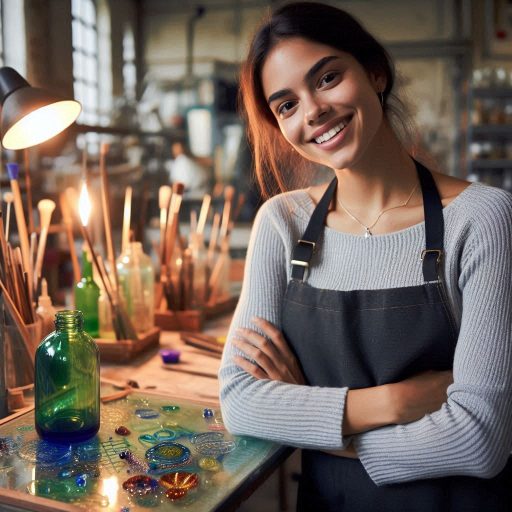Introduction
Sculpture has always evolved with artistic and technological advancements.
Today, digital technology is reshaping the landscape of sculpture.
Traditional methods like carving and casting are complemented by new digital techniques.
Digital tools offer artists unprecedented precision and flexibility.
Sculptors now use 3D modeling software to design intricate forms with ease.
These digital designs can be transformed into physical sculptures using 3D printing.
This innovation allows for complex structures that were once impossible to create.
Artists can experiment with virtual prototypes before committing to physical materials.
Moreover, digital tools enable sculptors to explore new materials and techniques.
Virtual reality and augmented reality offer new ways to interact with sculptural works.
These technologies help artists visualize their work in different environments and scales.
Digital technology also democratizes sculpture, making it accessible to a broader audience.
Online platforms and software lower the barriers to entry, allowing more people to engage with sculptural practices.
The integration of digital elements into traditional sculptural methods opens new avenues for creativity.
Artists can blend physical and digital elements to create hybrid sculptures that challenge conventional definitions of the art form.
As technology continues to advance, the future of sculpture will likely be marked by even greater innovation.
The fusion of digital and traditional techniques promises to expand the possibilities for sculptors and their audiences.
The digital age offers exciting opportunities for redefining sculpture and pushing the boundaries of artistic expression.
History of Sculpture
Evolution of sculpture from traditional methods to digital technology
Sculpture has evolved from traditional hand carving to digital modeling.
The use of digital technology has revolutionized the way sculptures are created.
Transform Your Career Today
Unlock a personalized career strategy that drives real results. Get tailored advice and a roadmap designed just for you.
Start NowTraditional methods involved sculpting with tools like chisels and hammers.
Digital technology allows artists to create intricate designs with precision.
Key turning points in the history of sculpture
The history of sculpture dates back to ancient civilizations like the Egyptians.
Ancient Greeks and Romans used sculpture to depict gods, heroes, and emperors.
The Renaissance period saw a resurgence in the appreciation of sculpture.
Artists like Michelangelo and Donatello created masterpieces that still inspire today.
The Industrial Revolution brought new materials and techniques to sculpture.
Sculptors began experimenting with metals, glass, and other innovative materials.
Modernism in the 20th century challenged traditional forms and pushed boundaries.
Artists like Pablo Picasso and Henry Moore embraced abstract sculptural styles.
The digital age introduced new possibilities for sculptors to explore technology.
3D printing, CAD software, and virtual reality have transformed the sculpting process.
Contemporary artists use digital tools to create works that blend art and technology.
Sculpture in the digital age continues to evolve, bridging the gap between art and innovation.
Read: Networking Tips for Art and Design Professionals
Impact of Digital Technology
How digital technology has revolutionized the field of sculpture
Digital technology has completely transformed the field of sculpture, ushering in a new era of creativity and innovation.
Artists are now able to utilize cutting-edge tools and techniques to push the boundaries of traditional sculpting methods.
Advantages and disadvantages of using digital tools in sculpting
Advantages of Using Digital Tools in Sculpting
- Increased precision and accuracy in creating complex shapes
- Ability to easily experiment and make changes without starting over
- Opportunity to collaborate with artists around the world in real-time
- Efficiency in production process, saving time and resources
- Integration with other digital platforms for showcasing and marketing artwork
Disadvantages of Using Digital Tools in Sculpting
- Loss of tactile experience and physical connection with the artwork
- Dependence on technology, which can be prone to glitches and failures
- High initial cost for digital equipment and software licenses
- Lack of traditional craftsmanship skills that are honed through manual sculpting
- Potential for artwork to become dated quickly as technology advances
In essence, while digital technology offers numerous benefits for sculptors, it also comes with its own set of challenges.
Finding a balance between embracing modern tools and techniques, and preserving the traditional artistry of sculpting, is key to shaping the future of sculpture in the digital age.
Read: Famous American Muralists and Their Iconic Works
Transform Your Career Today
Unlock a personalized career strategy that drives real results. Get tailored advice and a roadmap designed just for you.
Start NowAccessibility and Affordability
How digital tools have made sculpting more accessible to a wider audience
Digital tools have revolutionized sculpture, making it more accessible to a broader audience.
Artists now use 3D modeling software to create intricate designs without needing extensive physical materials.
This shift opens up opportunities for beginners and experienced sculptors alike.
Anyone with a computer and the right software can start sculpting from their own home.
Online tutorials and courses further break down barriers to entry, enabling people to learn sculpting techniques at their own pace.
Affordability of digital sculpting tools compared to traditional methods
Traditional sculpting often requires costly materials like marble or bronze, along with specialized equipment.
These materials are expensive and can be challenging to work with.
In contrast, digital sculpting tools are relatively affordable.
Software packages and 3D printers have become more accessible and budget-friendly.
As technology advances, the cost of high-quality digital tools continues to decrease.
Artists can now experiment with different styles and techniques without the financial burden of traditional materials.
Additionally, digital tools reduce the need for large studio spaces.
Sculptors can work from virtually anywhere, whether at home or in shared studio environments.
This flexibility further lowers the costs associated with traditional sculpting practices.
Overall, the digital age democratizes sculpture, allowing more people to engage with and contribute to the art form.
As technology evolves, the trend toward increased accessibility and affordability will likely continue, making sculpture an even more inclusive and dynamic field.
Read: Art and Design Professions: Career Growth and Salaries

Collaboration and Community
How digital technology has impacted collaboration among artists
Digital technology has revolutionized collaboration among artists.
Online platforms allow for real-time sharing of ideas and feedback.
Virtual reality tools enable artists to work together in immersive environments.
Transform Your Career Today
Unlock a personalized career strategy that drives real results. Get tailored advice and a roadmap designed just for you.
Start Now3D printing and scanning make it easy to share and replicate sculptures digitally.
The role of online communities
Online communities provide a platform for artists to network and collaborate.
Artists can crowdsource ideas, resources, and feedback through these platforms.
Social media platforms allow artists to showcase their work to a global audience.
Online forums and groups facilitate discussions on techniques, trends, and opportunities.
Shaping the future of sculpting
Digital tools have democratized the art world, making it more accessible to all.
Collaboration through digital platforms has led to innovative and diverse artworks.
Online communities foster creativity, learning, and support among artists worldwide.
The future of sculpture lies in the hands of a connected and vibrant digital community.
Read: How to Start a Career as a Professional Muralist
Innovation and Creativity
How digital tools have sparked innovation and creativity in sculptural design
Digital tools have revolutionized sculptural design, igniting innovation and creativity.
Artists now leverage software to create intricate designs with precision and ease.
Programs like CAD (Computer-Aided Design) allow sculptors to experiment with complex shapes and structures previously unimaginable.
These tools provide a digital playground where artists can visualize and manipulate their creations in three dimensions before bringing them to life.
3D printing has also become a game-changer in sculpture.
This technology enables artists to materialize their digital designs into physical forms quickly and accurately.
Sculptors can now create detailed models, test them, and refine their work with unprecedented efficiency.
The ability to print with various materials, from plastics to metals, opens up new possibilities for texture and finish.
How artists are pushing boundaries with new techniques and technologies
Artists are pushing boundaries with innovative techniques and technologies.
Some explore generative art, where algorithms and data influence the design process.
Transform Your Career Today
Unlock a personalized career strategy that drives real results. Get tailored advice and a roadmap designed just for you.
Start NowThis approach creates unique, unpredictable results that challenge traditional notions of artistic control.
Others use augmented reality (AR) and virtual reality (VR) to immerse viewers in interactive sculptural experiences.
These technologies allow audiences to engage with sculptures in dynamic and immersive ways.
Moreover, digital tools facilitate collaboration between artists and engineers.
By combining artistic vision with technical expertise, they produce sculptures that integrate mechanical elements or responsive features.
This fusion of art and technology results in works that move, change, or react to their environment, offering a new level of interaction.
In review, digital tools are driving innovation and creativity in sculpture.
Artists embrace new techniques and technologies, pushing the boundaries of what sculpture can be.
The future of sculpture is bright, with endless possibilities for exploration and expression in the digital age.
Preservation and Conservation
How digital technology is being used to preserve and conserve sculptures
Digital technology plays a crucial role in preserving and conserving sculptures.
3D scanning technology is commonly used to create high-resolution digital replicas.
These digital replicas serve as a valuable resource for conservation efforts.
Museums and cultural institutions leverage digital technology to document and store sculptures.
Digital archives help in monitoring the condition of sculptures over time.
Role of 3D scanning and printing in restoration efforts
Conservationists use 3D scanning to detect any deterioration or damages in sculptures.
The ability to create accurate digital replicas is essential for restoration projects.
3D printing allows for the replication of missing or damaged parts of sculptures.
Conservationists can use 3D printed parts to restore sculptures to their original state.
Digital technology enables conservationists to work with precision and accuracy.
It ensures that the original artistic intent of the sculpture is preserved.
Transform Your Career Today
Unlock a personalized career strategy that drives real results. Get tailored advice and a roadmap designed just for you.
Start NowThe use of digital tools in conservation helps in prolonging the lifespan of sculptures.
Conservation efforts supported by digital technology ensure the longevity of cultural heritage.
In general, the utilization of digital technology in preserving and conserving sculptures is revolutionizing the field of art conservation.
The ability to create high-resolution digital replicas through 3D scanning and printing has transformed the way in which conservators approach restoration projects.
By leveraging digital tools, conservationists can document, monitor, and restore sculptures with unmatched precision and accuracy.
This ensures that these cultural artifacts are preserved for future generations to appreciate and enjoy.
The future of sculpture in the digital age looks promising, with advancements in technology continuing to support the conservation and protection of these invaluable artworks.
Future Trends and Predictions
The digital age is reshaping the future of sculpture in exciting ways.
Artists and technologists are exploring new possibilities, blending traditional methods with cutting-edge innovations. Here’s a look at what to expect.
The future of sculpture in the digital age
The future of sculpture will likely be dominated by digital tools and techniques.
Artists will increasingly use 3D modeling and printing technologies to create complex forms.
These tools will enable unprecedented precision and detail in sculptural work.
Virtual reality (VR) will allow artists to visualize and manipulate their sculptures in immersive 3D environments.
Augmented reality (AR) will further enhance the viewer’s experience, enabling interactive and dynamic displays.
As digital fabrication becomes more accessible, we will see a rise in experimental and innovative sculptural forms.
The integration of AI will aid in generating new design ideas and automating aspects of the creative process.
Emerging trends and technologies that will shape the future of sculpting
Emerging technologies are driving significant changes in sculpture.
3D printing, for example, is transforming how artists create and display their work.
This technology allows for rapid prototyping and the production of intricate designs that were previously impossible.
Advances in materials science are providing sculptors with new, versatile materials to explore.
Transform Your Career Today
Unlock a personalized career strategy that drives real results. Get tailored advice and a roadmap designed just for you.
Start NowSmart materials that respond to environmental stimuli will enable sculptures to change and evolve in real-time.
The use of robotics and automation in sculpting processes will increase efficiency and open up new creative possibilities.
Digital platforms and social media will also play a critical role in how sculptures are shared and experienced globally.
Finally, collaborative projects between artists and technologists will lead to groundbreaking innovations in sculptural practice.
In a nutshell, the future of sculpture in the digital age promises to be dynamic and innovative.
Embracing these emerging trends and technologies will allow sculptors to push boundaries and redefine the art form.
Conclusion
The future of sculpture in the digital age offers exciting possibilities for artists worldwide.
By embracing technology, sculptors can create innovative and interactive pieces that redefine traditional art forms.
The use of 3D printing and virtual reality opens up new avenues for creativity and allows artists to push the boundaries of their craft.
Throughout this blog post, we have seen how digital tools have revolutionized the way sculptures are made and experienced.
From realistic renderings to kinetic installations, the digital age has transformed the art world in profound ways.
As we look ahead, we encourage readers to explore the endless possibilities that sculpting in the digital age has to offer.
Whether you are a seasoned artist or a newcomer to the world of sculpting, now is the perfect time to experiment with new tools and techniques.
By staying curious and open to innovation, we can all be part of a new era in sculpture that merges tradition with technology.
Let’s embrace the digital age and see where it takes us on this thrilling artistic journey.
The future of sculpture is bright, and we look forward to witnessing the incredible creations that emerge from this dynamic intersection of art and technology.
[E-Books for Sale]
The Big Book of 500 High-Paying Jobs in America: Unlock Your Earning Potential
$19.99 • 500 High-Paying Jobs • 330 pages
Explore 500 high-paying jobs in America and learn how to boost your career, earn more, and achieve success!
See All 500 High-Paying Jobs of this E-Book
1001 Professions Without a Degree: High-Paying American Jobs You Can Start Now
$19.99 • 1001 Professions Without a Degree • 174 pages
Discover 1001 high-paying jobs without a degree! Unlock career tips, skills, and success strategies for just $19.99!




